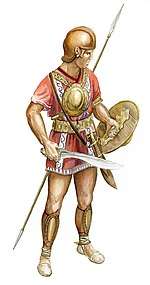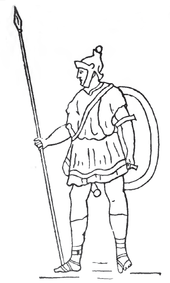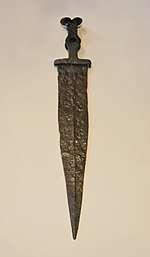Mercenaries of the ancient Iberian Peninsula
Mercenary life is recorded as a custom of Iron Age Spain, particularly in the central area of the Iberian peninsula. Departing from the native tribe and applying to serve in others was a way for economically disadvantaged youth to escape poverty and find an opportunity to use their fighting skills.[1] Starting from 5th century BC, mercenary life would become a true social phenom in Hispania, with great numbers of fighters from distant lands coming to join the armies of Carthage, Rome, Sicily and even Greece, as well as other Spanish peoples.[2]
.jpg)
They are repeatedly described by authors like Strabo and Thucydides as being among the best fighting forces in the Mediterranean Sea area, as well as, according to Livy, the most elite unit in Hannibal's army (id roboris in omni exercitu).[3] Polybius cites them as the reason for the Carthaginian victory in several battles during the Second Punic War.[4]
Background
Differentiating literal mercenaries from foreign vassals, brought to the battlefield through pacts or hostages instead of payment, is often difficult in ancient chronicles.[5] Similarly, the exact procedence of Spanish mercenaries are difficult to sort out either every time they are mentioned, as the terms used to refer to inhabitants of the Iberian peninsula are frequently vague, often using the generic "Iberian" to mean not only the coastal Iberian tribes, but any other people of Hispania. However, there is evidence that Hispania developed as a rich source of mercenary work during the early Iron Age. The reasons for this were mainly economic, as departing from the native tribe and serving in another, wealthier faction was a way for economically disadvantaged youth to escape poverty in their local lands, which were commonly subjected to sharp economic inequality. The main examples were found in Lusitania and Celtiberia, where cultivable terrains was concentrated among a few landowners, leaving mercenary life as the only alternative to banditry.[2] However, the long history of tribal warfare and warrior culture between tribes in Hispania cannot be discarded as another factor in their choice.[2] Natives from Balearic Islands and mountain folk from Cantabria were also recognized to have a strong mercenary tradition.[6]
Spanish mercenaries would not work individually, but in small-sized units formed by friends and relatives, managed by their own chiefs and keeping their own cultural traits, including armament and tactics.[1] Mercenaries having left Hispania didn't always return to their countries, and some of them, like Balearics, were known for spending all their gained money during their service,[7] but they would be met with prestige and fame among their countrymen if they did, given the warrior character of their societies.[5] However, their destinations were not always abroad, but also merely nearby regions of Hispania with a better economical profile, like Turdetania or Bastetania. Important southern war chiefes like Indortes, Istolatius and possibly Audax, Ditalcus and Minurus were Celts hired by the Turdetanians. Nevertheless, the most important roles played by Spaniard mercenaries in ancient story were in the armies of Carthage, Rome and Hellenic countries.[2] Important centers of recruitment were Gadir, Empúries, Castulo, Baria (modern day Villaricos) and the Balearic Islands.[5] Hispanic mercenaries were coveted for their toughness, discipline and skill, aside from their weapons, and not less for their ferocity; it was believable abroad that peninsulars even practiced cannibalism, like other barbarians supposedly did.[8]
5th-4th centuries BC

The first mentions of Spanish mercenaries come from the Sicilian Wars (460-307 BC), where they were part of the Carthaginian military in Sicilian ground. While they might have been already in their payroll as soon as 535 BC in their campaigns in Sardinia, their true introduction happened in the Battle of Himera in 480, when Diodorus and Herodotus tell they were part of the expedition of Hamilcar I against the Greek forces of Gelo.[2][5] Large contingents of Iberians reappear again in the capture of Selinunte, as well as the second battle of Himera, the battles of Akragas, Gela and Camarina, and the siege of Syracuse in 404 BC.[2][5]
However, possibly influenced by their success, Greeks started to employ Spaniards themselves in the Peloponnesian War, with Alcibiades bringing some with him to the Peloponnesian League after a recruitment campaign in Sicily. The latter conflict also saw the participation of Iberians in the Athenian coup of 411 BC, helping the oligarchs under the orders of Aristarchus of Athens.[2][5] In 396 BC, after the Carthaginian general Himilco abandoned all his mercenaries to their fate upon leaving Sicily in the Third Sicilian War, the Spanish peninsular forces were the only not to be annihilated. According to Diodorus, they banded up in battle formation and offered Dionysius I of Syracuse their services, impressing Dionysius into hiring them as a personal guard.[5] Later, in 368, his son Dionysius II sent a contingent of Celts and Iberians (an expression possibly meaning Celtiberians or other Spanish Celts) to the Theban–Spartan War in order to temporally relieve the Spartans in the siege of Corinth, which they accomplished.[2][5][9]
When Plato visited his apprentice Dionysius II in 361 BC, he witnessed a brief rebellion by the king's mercenaries due to his attempts to reduce their payment. They marched towards the acropolis chanting their war paean, scaring Dionysius II so much that he relented and gave them even more than they reclaimed.
3rd century BC
In 274 BC, Hiero II of Syracuse ended the traditional mercenary presence in Sicily in order to prevent more mutinies. He pitted them against the Mamertines, a body of Italian marauders, in the river Cyamosorus near the city of Centuripa, and then left them to their fate. Withholding his own citizen troops in order to stack the odds against the mercenaries, Hiero saw them being defeated and decimated.[10] Iberian peninsular mercenaries did not return to Sicily until the First Punic War in 264, this time for the Carthaginian army commanded by Hanno. When Carthage lost the war, unable to pay their emolument due to the economic sanctions imposed by Rome, the fighters returned to Africa and rebelled against them as part of the Mercenary War, being exterminated by Hamilcar Barca.[2][5] It would be in the Second Punic War, though, that Iberian peninsulars become a factor again, given that Hispania was the main front of the war.[11]

Upon Hamilcar Barca's arrival to Hispania in 237 BC, he succeeded at conquering multiple Hispanic tribes and drawing reinforcements through them, either through alliance or usage of hostages. His son Hannibal continued his effort after his death with plans to lead an expeditionary army to Italy. As mentioned earlier, in this case it is not easy to differentiate true partisans from forced vassals either, except whenever their procedence didn't equate with conquered regions, as apparently Hannibal only made a distinction out of his Spaniards about the topic of their allegiance.[5] In 218, before departing from Cartagena, he sent 16,000 Bastetani, Oretani and Olcade serfs to garrison Carthage in exchange for 15,200 African javelin throwers, thus preventing any possible rebellion of any of them due to the distance from their home lands.[12] He also licensed, before crossing the Pyrenees, many Carpetanians who did not wish to leave Hispania.[12] As a consequence of those moves, Hannibal kept only those Hispanics with a bond of devotion to him, which would presumably include mercenaries and the most loyal vassals. It is esteemed that between 8,000 and 10,000 Spaniards, counting the sum of their many peninsular peoples, reached Italy with Hannibal.[11] The majority of them might have been still alive and serving when he returned to Carthage in 202, proving the reliability that had moved the Punics to hire them.[8]
The variety and procedences of the mercenaries are not faithfully recorded, other than Celtiberians, Lusitanians and Balearics, which Hannibal would arrange and use for their particular talents. The first served as heavy cavalry, in contrast to the lighter, skirmishing Numidian cavalry, though they were also entrusted the front lines as infantry in battles like Cannae, where they stood out for their ability to hold the line.[11] Lusitanians are mentioned as having served as mountain troops, possibly playing the role of both skirmishers and heavy cavalry along with Celtiberians. Their combined force, composed of around 2,000 horsemen, was praised by Livy over their more numerous and famous Numidian homologues.[4][11] Finally, Balearics, ranging between 1,000 and 2,000, excelled as skirmishing infantry, being armed with famed slings capable to throw heavy shot over their enemies.[11] Silius Italicus speaks of even more tribes in the army, including Vettones, Gallaecians (combined with the Lusitanians in a single battalion), Cantabrians, Astures, and Vascones,[13] although authors have doubted of such diversity.[5] In any case, Celtiberians and Lusitanians probably were the main bodies of mercenaries, as Hannibal's spiel addressing them before the Battle of Ticinus attests.[14]

Other Celtiberians fought against Carthage after their pact with Rome, defeating Hasdrubal Barca's forces in 217 BC. Four years later, they became the first mercenaries employed by Rome, as Publius Cornelius Scipio was forced to hire them to retain their allegiance. According to Livy and Appian, he sent 200 to Italy in order to try to convince their countrymen in Hannibal's army into deserting. This empress had little success, but it might have helped to undermine Hannibal's trust on them.[5][14] In turn, Hasdrubal capitalized on his superior familiarity with Hispanic tribes to bribe Scipio's mercenaries, who agreed to abandon the Roman general even if they would not turn against him out of principles. The result was Scipio and his brother being killed near of Ilorci in 211 BC.[14] The same year, possibly inspired by a desertion of Numidians and Iberians to Marcus Claudius Marcellus after the Battle of Nola in 215, Celtiberians commander Moericus and Belligenus betrayed the Punic-allied Syracusians and joined Marcellus's entourage.[5][12] Another defection happened in Arpi, where 1,000 Hispanics chose to join the Roman side,[12] although this might have been an exchange to get 5,000 Africans out of the city and back with Hannibal.[8] Nevertheless, those seem to have been exceptions to the Hispanic mercenaries's loyalty. They generally held their Carthaginian masters in high regard, addressing them as their supreme commanders, and in many cases, like the defeats of Hasdrubal and Hanno, they died in suicide battle for them.[11] Hannibal considered his peninsular fighters to be among his most valuable forces, almost at the level of his African compatriots, and contrasting especially with the more expendable and undisciplined Gauls and Ligurians.[8]
In 209 BC, after gathering large contingents of Celtiberian and Cantabrian mercenaries, Hasdrubal departed Hispania for Italy in order to meet with Hannibal. His army arrived in 207 only to be discovered and defeated in the Battle of the Metaurus, where Hasdrubal was killed among the Spaniards, the last Punic forces to fall. Some Celtiberians managed to cut their way out and reach Hannibal.[14] The same year, generals Mago Barca and Hanno moved to Celtiberia to collect another army, but a new Roman attack, this time by Marcus Junius Silanus behind local guides and under orders from Scipio Africanus, ended it before they could depart too.[14][12] This would be a tough decision for the Roman side, as their intrusion in the Celtiberians's lands would put them against Rome again, making them join Indibilis and Mandonius's Iberian Ilergete revolt.[14][12] Anyhow, Mago managed to flee with 2,000 survivors to Gadir. After the Battle of Ilipa, he sent a prefect also named Hanno to gather yet another Celtiberian contingent, but the resultant Battle of the Guadalquivir ended the third and final attempt to maintain a large scale native army.[14] The remnant mercenaries, now 12,000 after the last levies,[8] were placed by Mago in an improvised fleet, which finally sailed towards Italy after having unsuccessfully retake Cartagena, not without hiring other 2,000 Balearics on the way.[14][12]
The last great deployments of peninsular mercenaries in the Second Punic War were in the territorial defense of Carthage. Taking command of 4000 Celtiberians from the Ilergete revolt previously sent by Mago, Hasdrubal Gisco and Syphax clashed with the invading Romans led by Scipio in the Battle of the Great Plains. The encounter was bitter to both the Celtiberians and Scipio, as the former had shown mercy to them in Hispania despite their allegiance to Indibilis and Mandonius, so the mercenaries knew the Roman general would not spare them a second time. Consequently, when the mercenaries found themselves being characteristically the last Carthaginian force standing in the battle, most chose to fight to the end and died in their posts.[5][14] There were further attempts to bring new Spanish fighters to Carthage, but the Saguntines captured the Carthaginian recruiters and sold them to Rome.[14] In 202 BC, Hannibal brought the remnant of his veteran mercenaries from Italy and united them to those of Mago, who had died in the sea while returning to Africa. They faced Scipio again in the Battle of Zama, being ultimately defeated and witnessing the end of the war. The loss of Carthage saw the end of the Punic mercenary tradition, as it was specifically written among the conditions imposed by Rome.
2nd-1st centuries BC
Despite the withdrawal of Carthage from Hispania, the peninsular custom of mercenary life survived the same. Between 197 and 195 BC, the Turdetanians employed 30,000 Celtiberians as elite troops during the Iberian revolt, while in 147 BC the Roman themselves sent them unsuccessfully against the Lusitanians led by Viriathus. Julius Caesar would also use Balearic slingers in the Gallic Wars.[15]
1st-4th centuries AD
The employment of Balearic slingers as mercenaries continued in the Imperial Roman army. The value of light infantry skilled in the use of stone missile throwing by slings was recognised as late as the 4th century AD, although by this date their recruitment basis had been extended from beyond Iberia and the Balearic Islands.[16]
References
- Joaquín Gómez-Pantoja, Eduardo Sánchez Moreno (2007). Protohistoria y Antigüedad de la Península Ibérica II (in Spanish). Sílex Ediciones. ISBN 978-84-773718-2-3.
- María Paz García-Gelabert Pérez, José María Blázquez Martínez. "Mercenarios hispanos en las fuentes literarias y la arqueología" (PDF) (in Spanish). Habis.
- Livy. Ab Urbe Condita Libri, 27, 14.
- María Paz García-Gelabert Pérez. "Estudio del Armamento prerromano en la península ibérica a través de los textos clásicos" (PDF) (in Spanish). Espacio, Tiempo y Forma.
- Benjamín Collado Hinarejos (2018). Guerreros de Iberia: La guerra antigua en la península Ibérica (in Spanish). La Esfera de los Libros. ISBN 978-84-916437-9-1.
- Eduardo Peralta Labrador (2003). Los cántabros antes de Roma. Real Academia de la Historia. ISBN 978-84-895125-9-7.
- Ruth Pliego Vázquez. "Sobre el reclutamiento de mercenarios turdetanos: el campamento cartaginés de El Gandul (Alcalá de Guadaira, Sevilla)" (PDF) (in Spanish). Universidad de Sevilla.
- Fernando Quesada Sanz. "De guerreros a soldados. El ejército de Aníbal como un ejército cartaginés atípico" (PDF) (in Spanish). Universidad Autónoma de Madrid.
- Phillip Harding (2015). Athens Transformed, 404-262 BC: From Popular Sovereignty to the Dominion of Wealth (in Spanish). Routledge. ISBN 978-13-174354-5-7.
- John Drogo Montagu (2015). Battles of the Greek and Roman Worlds: A Chronological Compendium of 667 Battles to 31 BC From the Historians of the Ancient World (in Spanish). Frontline Books. ISBN 978-14-738968-7-1.
- Gregory Daly (August 2005). Cannae: The Experience of Battle in the Second Punic War. Routledge. ISBN 978-11-345071-2-2.
- J. M. Blázquez. "Las guerras en Hispania y su importancia para la carrera militar de Aníbal, de Escipión el Africano, de Mario, de Cneo Pompeyo, de Sertorio, de Afranio, de Terencio Varón, de Julio César y de Augusto" (PDF) (in Spanish). Real Academia de la Historia.
- Silius Italicus, Punica
- Serafín Olcoz Yanguas, Manuel Medrano Marqués. "Los celtíberos y la ubicación de Celtiberia en el relato de la Segunda Guerra Púnica, de Tito Livio" (in Spanish). Espacio, Tiempo y Forma.
- Bellum Gallicum, 2.7
- Esposito, Gabriele. The Late Roman Army. p. 79. ISBN 978-0-9963657-9-6.